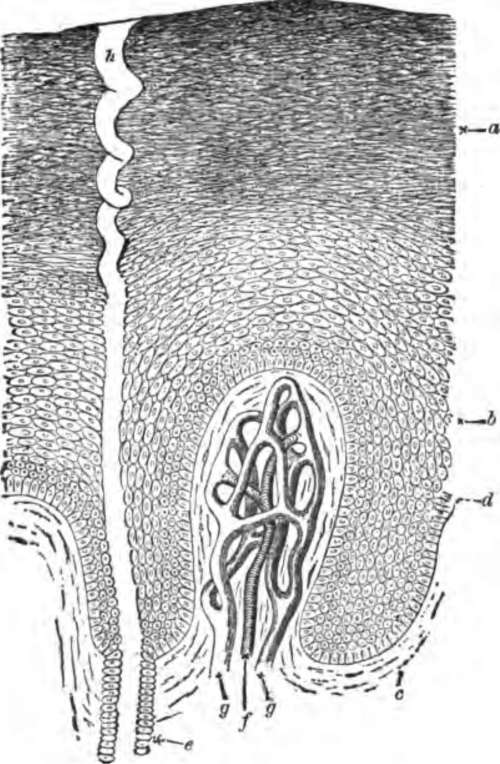The Skin
Description
This section is from the book "The Human Body: An Elementary Text-Book Of Anatomy, Physiology, And Hygiene", by H. Newell Martin. Also available from Amazon: The Human Body.
The Skin
The Skin, which covers the whole exterior of the body, consists everywhere of two distinct layers: an outer, the cuticle or epidermis ; and a deeper, the dermis, cutis vera, or corium. A blister is due to the accumulation of liquid between these two layers. Hairs and nails are excessively developed parts of the epidermis.
The Epidermis
The Epidermis, Fig. 75, consists of cells, arranged in many layers, and united by a small amount of cementing substance. The deepest layer, d, is composed of elongated or columnar cells, set on with their long axes perpendicular to the corium beneath. It is succeeded by several strata of roundish cells, b, which in the outer layers become more and more flattened in a plane parallel to the surface. The outermost epidermic stratum is composed of many layers of very flattened cells from which the nuclei (conspicuous in the deeper layers) have disappeared. These superficial cells are dead, and are constantly being shed from the surface of the body, while their place is taken by new cells, formed in the deeper layers, pushed up to the surface, and flattened in their progress. The change in the form of the cells as they travel outwards is accompanied by chemical changes ; they finally constitute a semi-transparent dry horny stratum, a, distinct from a deeper, more opaque, and softer layer, b and d, of the epidermis.
The rolls of material which are peeled off the skin on rubbing it with a rough towel after a warm bath, are dead outer scales of the horny stratum of the epidermis.
Of what two main parts does the skin consist? What is a blister? What are hairs and nails? Describe the epidermis.
What portion of it is constantly being cast off from the body ? What is meant by the horny stratum of the epidermis ? Of what do the rolls of matter consist which are peeled off the akin on vigorous rubbing after a warm bath ?
Nerves penetrate the epidermis, but no blood-vessels enter it. In dark races the color is due to a pigment contained chiefly in the deeper-placed cells of the epidermis.

Fig. 75. A section through the epidermis, somewhat diagrammatic, highly magnified. Below is seen a papilla of the dermis, with its artery, f, and veins, gg; a, the horny layer of the epidermis; b, the rete muscosum or Malpighlan layer; d, the layer of columnar epidermic cells in immediate contact with the dermis; A, the duct of a sweat-gland.
Does the epidermis contain nerves ? Blood-vessels? Where does the coloring matter of the skiu of negroes lie ?
The Corium, Cutis Vera, Or True Skin
The Corium, Cutis Vera, Or True Skin, Fig. 76, consists of a close feltwork of connective tissue, which, becoming wider meshed below, passes gradually into the subcutaneous areolar tissue, in texture much like damp raw cotton, which loosely attaches the skin to parts beneath. In tanning, the cutis vera is turned into leather, its connective tissue forming an insoluble and tough compound with the tannin of the oak-bark employed. "Wherever there are hairs bundles of plain muscular tissue are found in the corium; it contains also a close network of capillary blood-vessels, and numerous lymphatics and nerves. In shaving, as long as the razor keeps in the epidermis there is no bleeding; but a deeper cut shows at once the presence of blood-vessels in the true skin.

Fig. 76. A section through the skin and subcutaneous areolar tissue, a, horny stratum, and m, deeper more opaque layer of the epidermis; d, dermis passing below into sc, loose areolar tissue, with fat, f, in its meshes: above, dermic papillę are seen, projecting into the epidermis which is moulded on them, a, opening of a sweat-gland; gl, the gland itself.
Of what does the true skin consist ? Into what does it pass on its deeper side ? What is turned into leather when an ox-hide is tanned?
Continue to:
- prev: Alcohol Causes Kidney Disease In Several Ways
- Table of Contents
- next: The Papillae Of The Dermis
